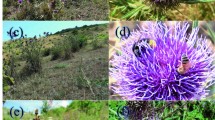Abstract
The pollination behavior of bumblebees and honey bees was studied on potato flowers in screened enclosures and in the field. In enclosures, the domestic honey bee (Apis mellifera L.) and the bumblebee species,Bombus fervidus Fabricius, seemed to lack any “cue” to initiate visitation of the flowers. When honey was placed on a few flowers, visitation was stimulated. The honey bee tore and chewed at the anther cone to collect pollen, whileB. fervidus probed for nectar which was not present. Shortly afterward, both species ceased visitation and could not be induced to visit further, regardless of the honey stimulus. Neither species was effective as a pollinator.
It is concluded that neither species will be useful for large-scale crossing of potato populations. However, another bumblebee species,Bombus impatiens Cresson, is very effective in pollinating potatoes in the field. Manipulating the behavior of such indigenous populations of bumblebees is likely to be the most effective method of exploiting insect pollination in the potato.
Resumen
La acción polinizadora de abejorros y abejas meliferas ha sido estudiada en flores de papa adentro de jaulas de malla y en el campo. Bajo condiciones de encierro la abeja doméstica (Apis mellifera L.) y los abejorros de la especie,Bombus fervidus Fabricius, aparentemente no recibieron “estimulo alguno” que los indujera a iniciar a las flores. Al colocarse miel de abeja sobre unas cuantas flores, se logró estimular visitas. La abeja melifera desgarró y masticó el cono de anteras con el objeto de colectar polen mientrasB. fervidus buscó nectar inexistente. AI poco tiempo, ambas especies, suspendieron las visitas y no se las pudo inducir a reiniciarlas a pesar del estimulo de la miel de abeja. Ninguna de las dos especies resultó efectiva como polinizadora.
Se concluye que ninguna de las dos especies sera util en la polinización cruzada de poblaciones grandes de papa. Sin embargo,Bombus impatiens Cresson, otra especie de abejorro, es muy efectiva como polinizadora de papa en el campo. La manipulatión del compartamiento de este tipo de población indigéna de abejorros será posiblemente el método más efectivo de explotar la polinización de papa por medio de insectos.
Similar content being viewed by others
Literature Cited
Buchmann, S. L. 1978a. A biophysical model for buzz pollination in angiosperms. J Theor Biol 72:639–657.
Buchmann, S. L. 1978b. Vibratile (“buzz”) pollination in Angiosperms with poricidally dehiscent anthers. Ph.D. Thesis, Univ. of Calif., Davis, 238 p.
Glendinning, D.R. 1976. Neo-Tuberosum: new potato breeding material. 4. The breeding system of Neo-Tuberosum, and the structure and composition of the Neo-Tuberosum gene-pool. Potato Res 19:27–36.
Heinrich, B. 1979.Bumblebee Economics. Harvard University Press, Cambridge, Mass. 245 p.
International Potato Center. 1978. Consumer potatoes from true seed, p. 43–44.In: CIP Annual Report. Lima, Peru.
Martin, M. W. 1978. Use of mass selection in early stages of potato breeding. Am Potato J 55:386. (Abstr.)
Medler, J. T. 1958. Principles and methods for the utilization of bumblebees in cross-pollination of crops. Proc Tenth Int Congr of Entomol 4(1956):973–981.
Medler, J.T. and D.W. Carney. 1963. Bumblebees of Wisconsin, Univ Wis-Madison Coll Agric Life Sci Res Div Res Bull 240. University of Wisconsin, Madison, Wisconsin.
Plowright, R. C. and S. C. Jay. 1966. Rearing bumblebees in captivity. J Apic Res 5:155–165.
Author information
Authors and Affiliations
Additional information
Cooperative Investigation of Agricultural Research, Science and Education Administration, U. S. Department of Agriculture and the Wisconsin Agricultural Experiment Station.
Rights and permissions
About this article
Cite this article
Sanford, J.C., Hanneman, R.E. The use of bees for the purpose of inter-mating in potato. American Potato Journal 58, 481–485 (1981). https://doi.org/10.1007/BF02874545
Received:
Issue Date:
DOI: https://doi.org/10.1007/BF02874545




